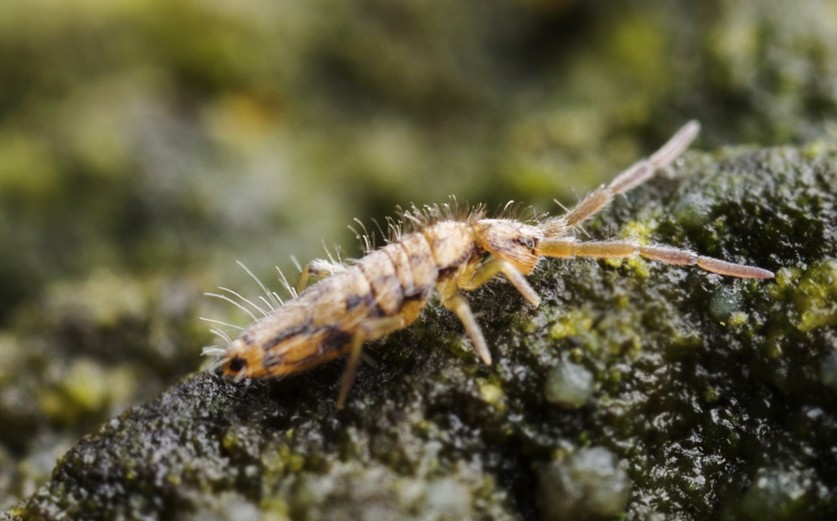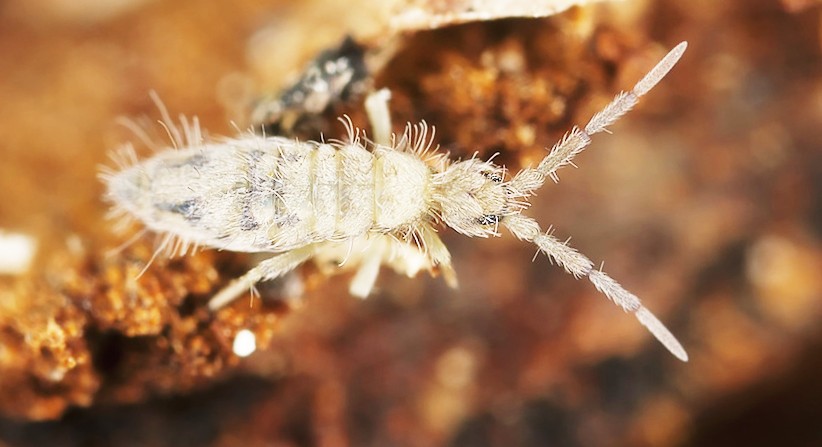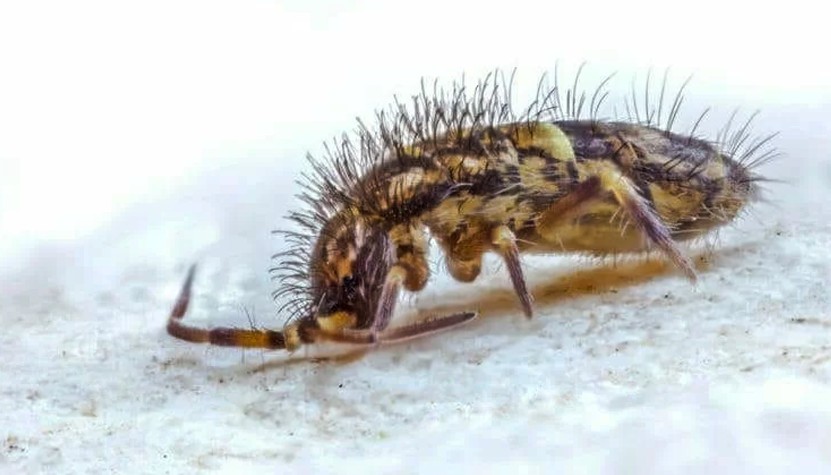Springtails

Springtails are tiny little, weird looking creatures might look like insects to you, but they are really not. They are one of the three largest lineages of the modern hexapods. They are a member of the Collembola order and pose no threat to humans in any form.
The springtails are very small in size and lie somewhere between the size of 1/16 inches and 1/18 inches. Can you imagine how tiny that is? The color of a springtail varies depending on its species. They are found in areas with high levels of moisture as well as organic debris. Learn everything about springtails, today.
How do Springtails look like?

The springtails are smaller than 6 mm in size and have as many as six abdominal segments. It comes with a tubular appendage that can also be referred to as the ventral tube or the collophore. The vesicles point outwards. Springtails are featured by their characteristics of a furcula or forked appendage. This can be found right under their abdomen.
The majority of the springtails are brown, black, grey, or dark colored. There are a few springtails that are of a lighter shade and can even be white. Their body shape is elongated, slender and at times it can also be stout and round in shape. However, the antennae on the springtails are of medium length.
These creatures lack wings which makes them incapable of flying. However, they have the potential to jump as high as several inches with the help of their forked structure. Some people confuse fleas with springtails. The obvious difference is fleas are flat with a hard body whereas springtails have soft, round body.
Habitat of Springtails
These are soil creatures and are found in leaf litter, soil, caves, fungi, decaying logs, under the bark of trees, and snowfields. These are also found along the seashores, vegetation, and freshwater pools. Springtails are found in the ants and termites. They flourish in large numbers in a minimal area. You can find as many 100,000 springtails in as little as a square foot of area. They can endure tropical, temperate, freshwater, rainforests, deserts, and in short – Everywhere!
How dangerous are Springtails?
There is no direct threat from springtails. They don’t bite, sting, or spread harmful diseases. Springtails can’t damage your property, but it is a real nuisance for any homeowner. When you leave the springtails alone, then they will start multiplying in no time which is a real disaster. They are very small in size and gather around places with a lot of moisture.
If you ever locate one springtail in your home, then be sure there are several others. These creatures infest homes in large numbers. Don’t be scared of them because they can’t chew on the things you eat or destroy your bedding, wood, clothing, and furniture. All they will do is roam around in abundance in your house.
Pictures of Springtails
Take a look at some of these amazing pictures of springtails:



Signs of Springtail Infestation
Springtails can be found everywhere. They feed on pollen, fungi, algae, and anything that is dead and decaying. Mostly they stay in mulch. Springtails move inside the house when your house has high moisture levels. You will find them mostly around bathrooms, plumbing leaks, kitchens, and basements.
If your house has springtails, then it is bound to be in the kitchen. Start looking for them under damp and moist areas like under the sink. They can be found in drain pipes, cabinets, and other places that show signs of mulch.
How to Get Rid of Springtails?
If you are creeped out by the millions of springtails crawling around in your home, then it is time to put an end to their reign of terror. These creatures have the ability to jump and can be seen in your kitchen, bedroom, and bathroom. Keep the feel and look of your home beautiful by getting rid of the springtails as soon as possible.
Here are some ways to deal with the springtail infestation:
Mildew and mulch are not only favorable conditions for it to live in, but they are also its favorite kind of food. If your house has an overgrowth of mulch or mildew or both, then be sure they are going to visit you in a large number. When you remove the food source of any creature, they are bound to live you alone.
Try wiping the area of the infestation multiple times with apple cider vinegar. The presence of high levels of acidity in apple cider vinegar will help you take care of the springtails. It will burn them and help you efficiently get rid of them. The added advantage of apple cider vinegar is it is antifungal in nature and will remove the molds.
Any kind of pest, parasite, insect, or hexapod can be dealt with effectively by the use of cedar oil. This essential oil can enter every crack and crevices in which springtails might be hiding. Choose only natural cedar oil and spray it under the carpets, sinks, kitchen, cabinets, and even on your beds and seats. You can even use them on your plants to prevent the overgrowth of springtails.
Use neem oil as a natural pesticide. The strong aroma of this oil is enough to drive away the springtails. Clean your house thoroughly and leave behind soaked balls of neem oil everywhere.
You need adequate amount of light in your house. Springtail population rises because of this. When you see springtails in your home, then choose better and brighter lamps or bulbs. You should also change your fixtures.
Look for the areas. By now you have clearly understood that springtails flourish in wet and damp areas of your home. It is time to locate the spots in your home that are damp. Water is of great importance to a springtail. The first thing to keep in mind is to get rid of the poor and incompetent drainage system.
Reduce the level of humidity in your house. Start by using a dehumidifier that can keep your house free from high levels of moisture build up. With better roof protection and insulation, you will be able to stop that. Rain is the main reason behind high levels of moisture in your home. When the air circulation is better the chances of moisture buildup will be low and result in lack of springtails in your home.
If your garden is clean, then your house is bound to be free from springtails. Start by removing any debris or stack of leaves that is accumulated anywhere in the garden. The soil shouldn’t be too wet or damp at any time. You need to aerate the soil and thatch it at regular intervals. If you can’t maintain the birdbaths, then it is time you remove them. Take care of the overwatered pots and the growth of mulch. Choose shaded places for your wood piles, fertilizers, compost, and other things that you need in your garden.
Diatomaceous earth is effective on every kind of insect, pests, and pesticides. Using gloves, sprinkle it all around your home and yard. There shouldn’t be any cracks, crevices, and holes that are left behind.
Bleach is known for its corrosive properties. When used along with soap and water solution it can take care of the springtail infestation. Mix it with soap and water. And, spray it either directly on them or the spots where you can spot them.
If the infestation is beyond your control, then you should call an expert to fumigate the whole area. For this, you will require an expert. The kind of chemicals they will use will be perfect for every pest.
Springtails will love to snuggle in the moist and fungus laden areas.
Springtails Facts
Facts about springtails that you will love to know:
- They are only about 1/16 inches in length.
- Neither can they fly, nor do they have wings.
- You will face the activities of springtails during the evening or night.
- Accumulation of organic debris as well as the damp conditions are perfect breeding grounds for springtails.
- There are as many as 500 species of springtails.
- Their color differs from one species to another. They can either be black, brown, white, grey, or bright in color.
- Springtails can be both oval and elongated. This depends on the kind of species they are.
- These creatures have a furcula. Do you know what that is? It is like a forked appendage that is right under their abdomen. This remains in place because of the tenaculum in its body; it is a fork like appendage under its body. They can jump as high as 8 inches in the air.
This article is an accumulation of every fact and detail that will help you understand a springtail. Follow the remedies we mentioned and keep them away from invading your home. Pests, no matter how harmless, shouldn’t be a part of your family.
